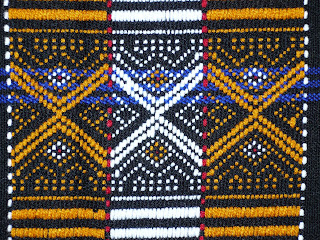Apatani Textile Product | 29 Dec 2021
Why in News
Recently, an application seeking Geographical Indication (GI) tag for the Arunachal Pradesh Apatani textile product has been filed by a firm.
Key Points
- About:
- The Apatani weave comes from the Apatani tribe of Arunachal Pradesh living at Ziro, the headquarters of lower Subansiri district.
- The Apatani community weaves its own textiles for various occasions, including rituals and cultural festivals.
- The woven fabric of this tribe is known for its geometric and zigzag patterns and also for its angular designs.
- The tribe predominantly weaves shawls known as jig-jiro and jilan or jackets called supuntarii.
- The people here use different leaves and plant resources for organic dying the cotton yarns in their traditional ways.
- Only women folk are engaged in weaving.
- The traditional handloom of this tribe is a type of loin loom, which is called Chichin, and is similar to the traditional handloom of the Nyishi tribe.
- It is portable, easy to install and operated by a single weaver, especially the female members of the community.
- The Apatani weave comes from the Apatani tribe of Arunachal Pradesh living at Ziro, the headquarters of lower Subansiri district.
- Apatani Tribes:
- Aaptani are a tribal group of people living in the Ziro valley in Arunachal Pradesh.
- They speak a local language called Tani and worship the sun and the moon.
- They follow a sustainable social forestry system.
- They celebrate major festivals – Dree with prayers for a bumper harvest and prosperity of all humankind and Myoko to celebrate Friendship.
- The Apatanis practice aquaculture along with rice farming on their plots.
- Rice-fish culture in the valley is a unique practice in the state, where two crops of rice (Mipya and Emoh) and one crop of fish (Ngihi) are raised together.
- It is a scheduled tribe in Arunachal Pradesh.
Present GI Products from Arunachal Pradesh
- Arunachal Orange (Agricultural)
- Idu Mishmi Textiles (Handicraft)
Tribes of Arunachal Pradesh
- The tribes of Arunachal Pradesh include: Abor, Aka, Dafla, Galong, Khampti, Khowa, Mishmi, Monpa, Momba, Any Naga tribes, Sherdukpen, Singpho.
Geographical Indication (GI) Tag
- About:
- A Geographical Indication (GI) is a sign used on products that have a specific geographical origin and possess qualities or a reputation that are due to that origin. In order to function as a GI, a sign must identify a product as originating in a given place.
- It is used for agricultural, natural and manufactured goods.
- International Protection for GI:
- Internationally GI are covered as a component of Intellectual Property Rights (IPRs) under the Paris Convention for the Protection of Industrial Property.
- The Paris Convention, adopted in 1883, applies to industrial property in the widest sense, including patents, trademarks, industrial designs, utility models, service marks, trade names, geographical indications and the repression of unfair competition.
- GI is also governed by the World Trade Organisation’s (WTO’s) Agreement on Trade-Related Aspects of Intellectual Property Rights (TRIPS).
- Internationally GI are covered as a component of Intellectual Property Rights (IPRs) under the Paris Convention for the Protection of Industrial Property.
- GI Protection in India:
- India, as a member of the World Trade Organisation (WTO), enacted the Geographical Indications of Goods (Registration & Protection) Act, 1999 which came into force with effect from 2003.
- The Act provides registration and also protection of GI goods in India.
- This Act is administered by the Controller General of Patents, Designs, and Trademarks, who is also the Registrar of Geographical Indications.
- The Geographical Indications Registry for India is located in Chennai.
- The registration of a geographical indication is valid for a period of 10 years. It can be renewed from time to time for a further period of 10 years each.
- Some of the examples of Geographical Indications in India include basmati rice, Darjeeling tea, Kancheepuram silk saree, Nagpur orange and Kolhapuri chappal.
- India, as a member of the World Trade Organisation (WTO), enacted the Geographical Indications of Goods (Registration & Protection) Act, 1999 which came into force with effect from 2003.
- Benefit of GI tag:
- Once the GI protection is granted, no other producer can misuse the name to market similar products. It also provides comfort to customers about the authenticity of that product.
- Having a GI tag for a product prevents unauthorised use of a registered Geographical Indication by others, boosts exports of Indian Geographical indications by providing legal protection and also enables seeking legal protection in other WTO member countries.

